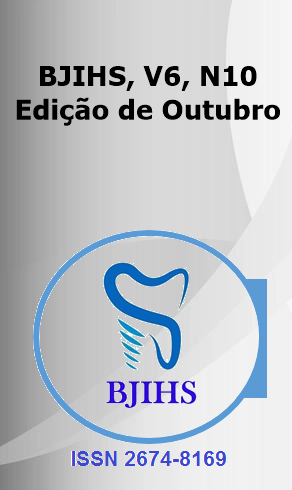Abstract
Introduction: Plants and natural medicines such as oregano extract can be a promising component in controlling contaminating bacteria, as well as a good ally in delaying pathogenic bacteria. Methodology: The present research utilizes the qualitative methodology at the Microbiology Laboratory of the Universidade Paranaense, aiming to evaluate the antimicrobial potential of the oregano extract. It involves using the nutrient agar culture medium for strains of Escherichia Coli and Staphylococcus Aureus ATCC 022. Two brands were selected, separated from the oregano extracts, and the test was applied in two groups with 15 (fifteen) nutrient agar culture media, in three different dilutions for each microorganism. Results and Discussions: Both the selected extracts had similar results for the 2 (two) microorganisms (Escherichia Coli and Staphylococcus Aureus). On the first dilution, it was used only 2 (two) drops of the extract, showing normal growth of the bacteria. On the second dilution, it was used 5 (five) drops of the extract, showing a reduced growth when compared to the first one. And finally, in the last dilution it was used 8 (eight) drops, in which there was proliferation only at the edge of the culture (in which there was no presence of the extract), suggesting a bacteriostatic potential. Bacterial replication revealed normal growth of E.Coli and S. aureus, suggesting that the extracts had a non-bactericidal effect. Final considerations: After the experiment was finished, the extracts used demonstrated the expected bacteriostatic effect for the Escherichia Coli bacteria, while for the Staphylococcus Aureus bacteria, there was a discrepancy between the results and the extracts. However, it is worth highlighting that the medical use of the oregano extract can be a great ally in the fight against infectious diseases, as many studies prove its effectiveness.
References
ALMEIDA, Regiamara Ribeiro. Mecanismos de ação dos monoterpenos aromáticos: timol e carvacrol. São João del-Rei: Universidade Federal de São João del-Rei, 2015.
ARAUJO, Márcio Martins de; LONGO, Priscila Larcher. Teste da ação antibacteriana in vitro de óleo essencial comercial de Origanum vulgare (orégano) diante das cepas de Escherichia coli e Staphylococcus aureus. Arquivos do Instituto Biológico, v. 83, 2016. DOI: https://doi.org/10.1590/1808-1657000702014.
DE LIMA, Dijaci Santos; et al. Estudo da atividade antibacteriana dos monoterpenos timol e carvacrol contra cepas de Escherichia coli produtoras de β-lactamases de amplo espectro. Revista Pan-Amazônica de Saúde, v. 8, n. 1, p. 5-5, 2017. DOI: http://dx.doi.org/10.5123/s2176-62232017000100003.
DE SOUZA MOREIRA, Bianca; AZOLA, Juliana da Silva Menezes; GOUVÊA, Cibele Marli Cação Paiva. Marcadores moleculares para identificação e caracterização do potencial patogênico de Escherichia coli e Staphylococcus aureus. SaBios-Revista de Saúde e Biologia, v. 13, n. 1, p. 41-52, 2018.
LEITE, Lucimary; et al. Uso indiscriminado de antibióticos e o risco de resistência bacteriana: revisão de literatura. Brazilian Journal of Implantology and Health Sciences, v. 6, n. 1, p. 438–452, 2024. DOI: https://doi.org/10.36557/2674-8169.2024v6n1p438-452.
MILLEZZI, Alessandra Farias; et al. Sensibilidade de bactérias patogênicas em alimentos a óleos essenciais de plantas medicinais e condimentares. Higiene Alimentar, São Paulo-SP, v. 30, n. 254/255, p. 117-122, 2016.
MORENO, Diego; et al. Consumo de antimicrobianos e o impacto na resistência bacteriana em um hospital público do estado do Pará, Brasil, de 2012 a 2016. Revista Pan-Amazônica de Saúde, v. 10, 2019.
OLIVEIRA, Amanda Cristina Dias de. O uso de extrato de orégano (Origanum vulgare) no controle de bactérias da fermentação etanólica a partir de cana-de-açúcar. 2021.
Pimenta, Priscila Abreu; et al. Avaliação da atividade antimicrobiana e potencial conservante do óleo essencial de orégano (Origanum vulgare). Scientia Plena, v. 20, n. 2, 2024. DOI: https://doi.org/10.14808/sci.plena.2024.026201.
RODRIGUES, Nyara; et al. Análise de tendência de mortalidade por sepse no Brasil e por regiões de 2010 a 2019. Revista de saúde pública/Revista de Saúde Pública, v. 56, p. 25–25, 2022. DOI: https://doi.org/10.11606/s1518-8787.2022056003789.
SCHERER, Carolina; et al. Mecanismos de ação de antimicrobianos e resistência bacteriana. Revista de Educação Continuada em Dermatologia e Alergologia Veterinária4(13); 12-20, 2017.
SIQUEIRA, Batista Rodrigo; et al. Sepse: atualidades e perspectivas. Revista brasileira de terapia intensiva, v. 23, n. 2, p. 207–216, 2011. DOI: https://doi.org/10.1590/S0103-507X2011000200014.
TALAPKO, Jasminka; et al. Candida albicans – os fatores de virulência e manifestações clínicas da infecção. Revista de Fungos, v. 7, n. 2, pág. 79, 2021. DOI: https://doi.org/10.3390/jof7020079.
WIJESUNDARA, N. M.; Rupasinghe. H. P. V. Essential oils from Origanum vulgare and Salvia officinalis exhibit antibacterial and anti-biofilm activities against Streptococcus pyogenes. Microbial Pathogenesis, 117, 118-127, 2018. DOI: https://doi.org/10.1016/j.micpath.2018.02.026.

This work is licensed under a Creative Commons Attribution 4.0 International License.
Copyright (c) 2024 Carla Klais Maciel, Gabrielle Temporini, Grazielle Mecabo, Anderson Felipe, Barbara Sackser Horvath

